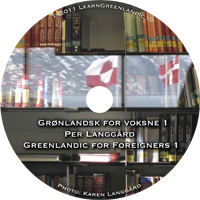The great idea with Learn Greenlandic with Per Langgård is not only to teach you about Greenlandic, rather to help you grasp the edge of the Greenlandic language in the real world as fast and efficiently as possible to set you off acquiring functional Greenlandic the natural way, namely by using the language as it is spoken and written in Greenland outside the L2 classroom.
We know from L2 theory, from concrete testcourses and from experiences with good language learners gathered over many years that our strategies form a viable road towards functional Greenlandic (and that it really is the only road we’ve ever seen work in the real world). Keep in mind, though, that success depend on you accepting the fact that acquisition is an individual process (it is your responsibility, not your language teacher’s) and that it is the language in itself including all its problems and pitfalls that must be your “teacher”. Nobody acquires a language from a grammar book, a compendium or a smart app. Such might support your understanding and strengthen your motivation but real language acquisition happens only when you hear, read, speak and write the language itself, not through reading about it.
Such views are anchored in the psycholinguistic model, The Input Hypothesis, and will be the starting point for all methodology in the many chapters to follow here.
You acquire step by step, not by whole chapters
You have acquired whatever L2 you master in basically the same way: You heard/ read L2 (words or sentences) a number of times until you turned able to produce it as sound or as written text without too much effort. Then you started up on the next bit of language needed and got that under your skin as with the first bit. Over a number of months or years you then gathered and organized the bits into the functional L2 you now master.
Here is an example: When you learned German L2 you at some point had to realize that der Mann will not help you express ‘I saw the man’. You need the accusative to form the correct Ich habe den Mann gesehen. You might also at the same time have learned to say Ich habe die Frau gesehen and Ich habe das Mädchen gesehen (that is not *den Frau and *den Mädchen) but apart from that you unlikely were taught more about the accusative before you needed it in other contexts. That is, you used the grammar to help you better understand present needs, not to get an overview of case accusative.
Grammar exclusively exploited to assist with concrete problems you run into has been termed Integrated Focus on Forms. It is the single kind of grammar you will meet over the many chapters to follow here. You will not use paradigms etc. but you will always get a solid explanation with every problematic word you encounter during your acquisition process.
The number of derivational and inflectional endings in Greenlandic is so immense that anyone but linguistic geniuses will get lost in them without acquiring any well enough for use in the real world. And that is the beginning of the end to all motivation. That is why we choose the natural way, namely to internalise every new bit of language before setting out for the next.
We know from experience that this strategy works. At Brug systemet you will find a step by step guide to a tested study guide including a few short clarifications about the rationales behind the priorities we choose to follow.
Good luck with the project. Per Langgård

 Language
Language